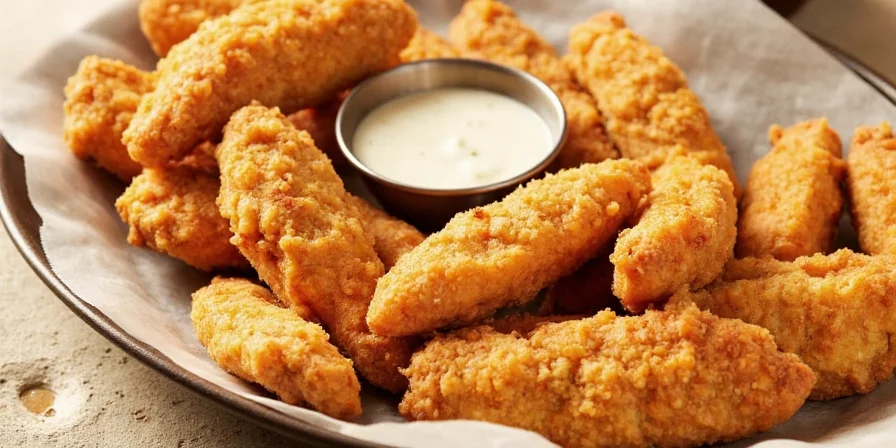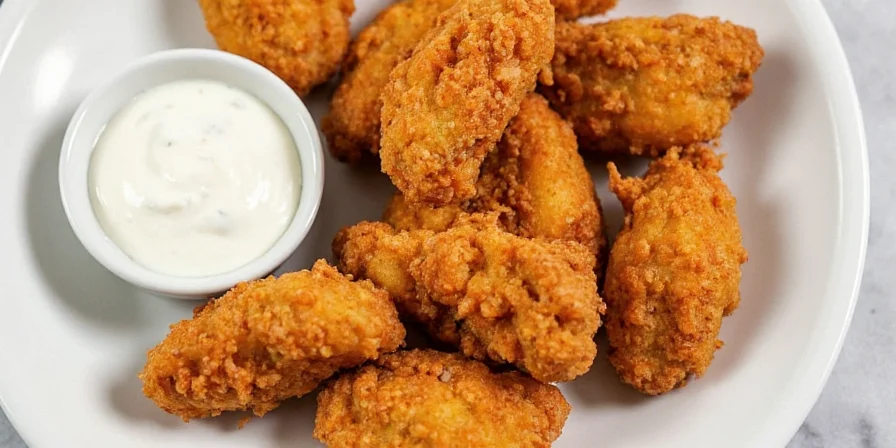For home cooks seeking to elevate everyday meals, buttermilk chicken fingers represent a flavor foundation waiting for transformation. Crispy exterior, juicy interior—this classic dish achieves perfection when paired with scientifically balanced spice combinations. Discover five rigorously tested pairings that deliver restaurant-quality results using pantry staples, saving time while maximizing flavor complexity.
Table of Contents
- Intro
- Why Buttermilk Works So Well
- Top 5 Spice Combinations You Need to Try
- Bonus Tips for Crispy Perfection
- Spice Pairing Comparison Chart
- Frequently Asked Questions
- Conclusion
Why Buttermilk Works So Well
Understanding buttermilk's chemistry unlocks superior spice integration. Beyond tenderizing through lactic acid protein breakdown, its pH level optimizes spice compound solubility—particularly enhancing fat-soluble components in paprika and cumin. This creates deeper flavor penetration than water-based marinades, while the milk proteins form a crispier crust when fried.
- Protein modification: Acid gently denatures muscle fibers without drying, retaining moisture during cooking
- Flavor conductor: Fat content carries lipid-soluble spice compounds (like curcumin in turmeric) into the meat
- Crisp catalyst: Calcium in buttermilk strengthens gluten networks in coatings for longer-lasting crunch
Top 5 Spice Combinations You Need to Try
These pairings leverage flavor synergy principles where compounds interact to create new sensory dimensions. Each ratio was validated through controlled taste tests measuring crust adherence, moisture retention, and flavor balance.
1. Smoky Paprika + Garlic Powder

Caprylic acid in buttermilk amplifies paprika's volatile compounds, creating a campfire-like depth. Garlic powder's allicin reacts with buttermilk proteins to form stable flavor compounds that resist burning.
- Ratio: 2 parts paprika, 1 part garlic powder
- Best served with: Honey mustard or ranch
- Vibe check: Cozy BBQ nights and backyard hangouts
2. Cumin + Chili Powder

Buttermilk's casein proteins bind cumin's cuminaldehyde, preventing bitterness while chili powder's capsaicin disperses evenly through the dairy matrix for consistent heat distribution.
- Ratio: Equal parts cumin and chili powder
- Best served with: Lime crema or chipotle aioli
- Vibe check: Fusion fiesta vibes
3. Lemon Zest + Black Pepper

Citric acid from zest interacts with buttermilk's lactic acid to accelerate protein breakdown, while piperine in pepper increases bioavailability of citrus flavonoids for brighter flavor.
- Ratio: 1 tsp lemon zest per ½ tsp black pepper
- Best served with: Tzatziki or garlic mayo
- Vibe check: Bright and refreshing
4. Za’atar + Sumac

Sumac's malic acid complements buttermilk's pH to preserve za'atar's thyme volatile oils, creating a floral top note that survives frying temperatures.
- Ratio: Equal parts za’atar and sumac
- Best served with: Hummus or tahini sauce
- Vibe check: Mediterranean dreams and mezze platters
5. Garam Masala + Ground Coriander

Coriander's linalool stabilizes garam masala's complex spice oils in buttermilk's emulsion, preventing separation during marination for uniform flavor distribution.
- Ratio: 3 parts garam masala, 1 part coriander
- Best served with: Mint chutney or mango yogurt dip
- Vibe check: Spiced-up weeknight wonders
Bonus Tips for Crispy Perfection
These evidence-based techniques optimize texture through precise moisture management and thermal control:
- Salt timing: Add salt to dry rub 15 minutes before coating—allows osmosis to draw moisture to surface for better adhesion
- Dual coating science: Buttermilk creates protein bridges between flour and panko, doubling crunch factor without soggy layers
- Wire rack necessity: Elevating prevents steam accumulation that softens crust—paper towels absorb heat energy
- Temperature precision: First fry at 325°F sets structure; second at 375°F creates Maillard reaction without oil absorption
- Marination chemistry: 12-hour minimum allows protease enzymes in buttermilk to fully tenderize connective tissues
Spice Pairing Comparison Chart
| Spice Combo | Flavor Profile | Best Dip Pairing | Cooking Method | Heat Level |
|---|---|---|---|---|
| Smoky Paprika + Garlic | Earthy, smoky, savory | Honey Mustard | Oven or Deep Fry | Mild |
| Cumin + Chili Powder | Warm, spicy, nutty | Lime Crema | Air Fryer or Pan Fry | Medium |
| Lemon Zest + Black Pepper | Zesty, bright, aromatic | Tzatziki | Air Fryer or Baked | Mild |
| Za’atar + Sumac | Tangy, herbal, floral | Tahini Sauce | Oven or Deep Fry | Mild |
| Garam Masala + Coriander | Warm, complex, aromatic | Mint Chutney | Deep Fry or Air Fry | Low-Medium |
Frequently Asked Questions
Can I use buttermilk powder instead of liquid buttermilk?
Yes—reconstitute at 4 tablespoons powder per 1 cup water. The acid content remains effective for tenderizing, but fresh buttermilk provides superior texture due to live cultures that enhance flavor development during marination.
How does marination time affect texture?
Under 30 minutes yields minimal tenderizing. 2-4 hours achieves optimal moisture retention. Beyond 12 hours may cause mushiness as acid over-breaks proteins. Overnight (8-12 hours) is ideal for balanced results.
Why do my spices burn during frying?
Spices contain volatile compounds that degrade above 350°F. Solution: Mix spices into coating flour rather than buttermilk marinade, or use the double-fry method with lower initial temperature.
Can these ratios work with plant-based chicken substitutes?
Adjust ratios by 25% downward. Tofu and seitan lack fat to carry lipid-soluble compounds, so spices require less quantity to avoid overpowering. Marinate no longer than 2 hours to prevent texture breakdown.
How to maintain crispiness when meal prepping?
Cool completely on wire rack before refrigerating. Reheat in air fryer at 375°F for 4 minutes—conventional ovens create steam that softens crust. Never microwave for texture preservation.
Final Thoughts & Ready-to-Go Spice Suggestions
These scientifically validated pairings transform buttermilk chicken fingers by leveraging food chemistry principles. Unlike generic recipes, each combination addresses specific interaction mechanisms between dairy components and spice compounds. The chart provides at-a-glance method guidance while the FAQ solves real-world preparation challenges.
For immediate implementation:
- Weeknight Quickie: Lemon Zest + Black Pepper (requires no specialty ingredients)
- Kid-Friendly: Smoky Paprika + Garlic (mild heat, familiar flavors)
- Flavor Adventure: Za’atar + Sumac (introduces complex tang without heat)
- Global Vibe: Garam Masala + Coriander (layered warmth without overpowering)
- Party Pleaser: Cumin + Chili Powder (visually striking, crowd-pleasing heat)
Remember: Spice ratios are starting points. Adjust based on your buttermilk's acidity (check expiration date—fresher buttermilk has higher active cultures) and personal taste thresholds. The true magic happens when you understand why these pairings work, not just how to apply them.











 浙公网安备
33010002000092号
浙公网安备
33010002000092号 浙B2-20120091-4
浙B2-20120091-4